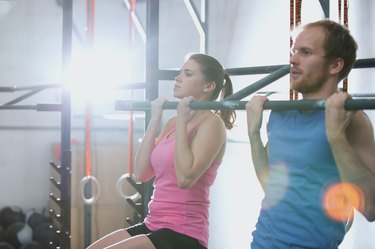
Pullups are one of the best upper-body exercises you can do, but they aren't without risk. Improper form or doing too many too soon can lead to discomfort, pain or injury. If you experience pain in the back of your neck following a set of pullups, examine your technique, and if the pain is severe or lingers for several days, consult a health care provider.
The Proper Pullup
Video of the Day
You may have been doing pullups since gradeschool but that doesn't mean you're doing them correctly. For classic pullups, step up to a well-secured bar and grasp it with a full, overhand grip -- fingers wrapped over the top of the bar and thumbs underneath. Your hands should be slightly wider than shoulder-distance apart. Hang with your elbows extended and then bend your elbows as you pull your chin up and over the bar. Lower your body in control until your elbows are completely extended and then repeat. Pullups may be done chin-up style -- with an underhand grip -- or with a neutral grip, where your palms face inward, to target more forearm and biceps muscles.
Video of the Day
Cheating Up
For your pullup to bring you through full range of motion and thus maximize muscle activation, you must get your chin over the bar. However, doing this by tilting your head back and straining your neck can cause pain in the back of your neck. This distorted technique also cheats you out of the benefits of pullups because you aren't truly using your back muscles to pull you up. Doing certain pullup versions without a solid base of strength, such as the kipping version -- in which you swing your hips to get yourself up and over the bar -- can also be a recipe for injury and pain in the shoulders or back of the neck.
Building Strength With Assisted Pullups
If you strain your neck to reach up and over the bar, evaluate your readiness for pullups. You may need to build proper strength before trying to execute a full dead-hang, body-weight pullup. Use an assisted pullup machine, which supports some of your weight, to build proper form without straining to reach your chin over the bar. If you don't have access to an assisted pullup machine, have a spotter hold your legs to support some of your weight as you train. Consider training with an underhand grip, which can be easier to master than the wide-grip, overhand pullup, which is the most challenging version.
Exercises to Build Up
Doing other exercises to build up the muscles required for full pullups can also help you build the necessary strength so you don't need to crank your neck up to get your chin over the bar. Lat pulldowns, biceps curls and dumbbell rows are examples of these strengthening exercises. Train with pullups just two or three times per week on nonconsecutive days to ensure you aren't overtraining, which can also cause pain in your neck and other muscles, over time.
When to Worry
If you feel a sudden pop or crack during pullups that causes neck pain, stop immediately and consult your doctor. For mild pain or strain, rest and ice are the typical treatments. Common sense also dictates that you should avoid pullups until your pain dissipates or you risk aggravation of the pain.